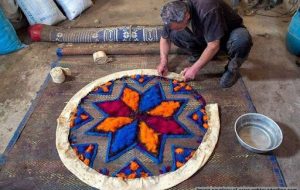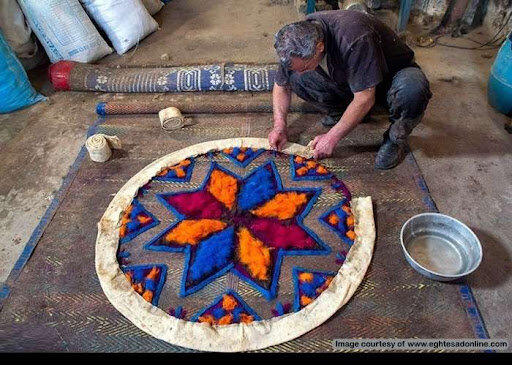Traditional felt-making in Semnan province
TEHRAN – Felt-making by pressing and rolling woolen fibers has long been practiced in many villages across Semnan province. The craft called Namad-mali (“felt beating”) by the locals, involves creating Namad, which is a modest flooring. To create a felt piece, the felt maker starts by arranging colored wool according to a specific design on


TEHRAN – Felt-making by pressing and rolling woolen fibers has long been practiced in many villages across Semnan province.
The craft called Namad-mali (“felt beating”) by the locals, involves creating Namad, which is a modest flooring.
To create a felt piece, the felt maker starts by arranging colored wool according to a specific design on a base fabric known as Karbas, similar to canvas. Layers of combed wool are added, and the entire piece is rolled and pressed repeatedly, with hot water applied throughout the process.
While the basic process of felt-making is similar across various regions of Iran, the felts from Semnan are distinguished by their unique patterns, colors, and textures, reflecting the local cultural and environmental influences.
Historically, felt is believed to be one of the earliest forms of floor covering known to humanity. A well-known legend in Semnan tells of how Prophet Solomon’s son, a shepherd, inadvertently created the first felt. After unsuccessfully trying to weave wool from his sheep, he, in frustration, began to beat the wool with his fists, weeping over it. His tears mixed with the wool fibers, binding them together and forming the first felt.
In Semnan, felt is primarily made from the long-fiber wool of sheep, shorn in the spring. Despite the labor-intensive nature of the craft, felt can be produced within a single day, making it an accessible and relatively inexpensive textile.
Felt is crafted without the use of a loom or knitting. The process relies on moisture and pressure. Wool fibers are laid out and repeatedly pressed and rolled under hot water, causing the fibers to interlock and form a durable, compact fabric.
Though traditionally used as floor coverings, felts from Semnan also serve various purposes, including traditional covers, horse blankets, kitchen accessories, dolls, and even garments. Patterns used for them often feature abstract motifs inspired by nature, such as solar symbols, paisley, and geometric shapes like diamonds.
AM
